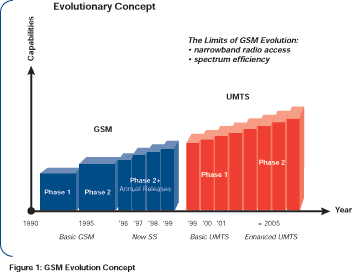
Introduction
In the early days of wireless communication, service was limited to the range of a single base station that covered a small geographic area known as a cell 1. The advantages of wireless communication became readily apparent, but users were still tied to the base station by their limited range. Truly mobile communication would require a greater freedom for the user.
Technical innovations such as automatic switching and reductions in hardware costs, size and weight led to the first generation of mobile communication systems to meet this requirement. First generation systems were based on analog cellular technology. Well-known examples include Advanced Mobile Phone Service (AMPS), Nordic Mobile Telephone (NMT), and Total Access Communication System (TACS).
The transmission quality of these first generation systems, however, left much to be desired and each system used proprietary architecture which made cooperation nearly impossible. With the development of ISDN and digital switching, subscribers enjoyed a range of new features and conveniences on the fixed network which were unavailable on the analog-based mobile networks.
To overcome some of the disadvantages of the first generation systems, a new digital system was developed the Global System for Mobile Communication (GSM). Often referred to as a second generation system, GSM increased the transmission quality and air interface efficiency and introduced services similar to ISDN. Security features such as ciphering and authentication were taken very seriously, and international roaming became possible. The CCITT began developing a consistent and open GSM standard to ensure unlimited mobility and a competitive market for this technology. (This work was later continued by ETSI.)
GSM proved to be extraordinarily successful. In the early 1990s, experts estimated that there would be 10 million subscribers in Europe by the year 2000. Today, more than 250 million GSM subscribers can be found all over the world. Many countries adopted the European standard and over 250 operators worldwide now offer GSM service. It soon became obvious that GSM would need to be developed as an evolutionary system, so that new features could be added based on market demands.
- GSM Phase 1 was passed in 1991. User data and full rate voice transmission (up to 9.6 kbps) were introduced. Some supplementary services were specified.
- GSM Phase 2 was realized in 1995. An extensive set of supplementary services was introduced along with a half rate speech codec and downward compatibility.
- GSM Phase 2+ refers to the ongoing process of adding new features to GSM in Annual Releases. Recent advancements include HSCSD, GPRS, CAMEL, EFR, and EDGE.

Third generation (3G) mobile communication systems currently in development will further extend the range of applications available to mobile users. These technologies are referred to as Universal Mobile Telecommunication Service (UMTS), Wideband Code Division Multiple Access (WCDMA) and International Mobile Telephony 2000 (IMT-2000) 2. Because of the wide distribution of mobile communication networks, the focus lies not only on increasing the efficiency of the air interface and broadband data transmission, but also on the reuse of existing investments in second generation mobile communication networks. With UMTS, a new Terrestrial Radio Access Network (UTRAN) will be integrated in the existing core network solutions (GSM-NSS, IS-41 3). GPRS is the first step in creating an enhanced GSM core network solution for UMTS.
1 This historical fact is still evident in the use of the word cellular or cell phone when referring to mobile communication
2 Additional information is available in UMTS Protocols and Protocol Testing Lit. No. 2FW-14251-0
3 IS-41 is the core network for IS-95, D-AMPS, and AMPS

